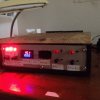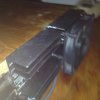Hey guys
I'm a little stumped as I just put my power supply together which long story short consists of an lm317 driving two 2n3055 pass transistors.
These 2n3055's are rated for 15 amps each and they're paralleled so I should theoretically get 30 amp handling capacity.
I tested it out last night with a little portable drill that I butchered to have 12v leads comming off for portable work requirements.
It worked for a while so I started drilling some holes in the power supply case (timber so no chance of a short). They were only getting slightly warm when I noticed the output voltage was giving a full 30v's instead of the regulated setting I had at 14v.
Is it possible that while tightening the chuck on the drill (motor in drill only slightly moving while holding the chuck key with hand to put a new drill bit in) That I drew more than 30 amps and blew them both?
I thought these things had overload protection?
To give you an idea of my schematic it looks like the one in this link -
https://docs.google.com/viewer?a=v&...iZXR0aW5hbmV1bXJ5cnxneDo1ZWMyNWUzNTliYWYyMDRl
Except for the control circuitry is an lm317 instead of the lm723 I.C shown in this schematic.
I also don't have a diode going from the emitter back to the collector, I'm not sure why they put this here? Should I also have a resistor for each of the bases of these pass transistors to help with load sharing? Before blowing they both were getting a tiny bit warm with a 2 amp load at 12v after about 2 minute but not hot by any means.
Should I also have a resistor for each of the bases of these pass transistors to help with load sharing? Before blowing they both were getting a tiny bit warm with a 2 amp load at 12v after about 2 minute but not hot by any means.
Any help would be appreciated thanks in advance
Ordered some 30 amp automotive fuses off ebay and some new 2n3055 transistors.
Regards -
Damien
I'm a little stumped as I just put my power supply together which long story short consists of an lm317 driving two 2n3055 pass transistors.
These 2n3055's are rated for 15 amps each and they're paralleled so I should theoretically get 30 amp handling capacity.
I tested it out last night with a little portable drill that I butchered to have 12v leads comming off for portable work requirements.
It worked for a while so I started drilling some holes in the power supply case (timber so no chance of a short). They were only getting slightly warm when I noticed the output voltage was giving a full 30v's instead of the regulated setting I had at 14v.
Is it possible that while tightening the chuck on the drill (motor in drill only slightly moving while holding the chuck key with hand to put a new drill bit in) That I drew more than 30 amps and blew them both?
I thought these things had overload protection?
To give you an idea of my schematic it looks like the one in this link -
https://docs.google.com/viewer?a=v&...iZXR0aW5hbmV1bXJ5cnxneDo1ZWMyNWUzNTliYWYyMDRl
Except for the control circuitry is an lm317 instead of the lm723 I.C shown in this schematic.
I also don't have a diode going from the emitter back to the collector, I'm not sure why they put this here?
Any help would be appreciated thanks in advance
Ordered some 30 amp automotive fuses off ebay and some new 2n3055 transistors.
Regards -
Damien





